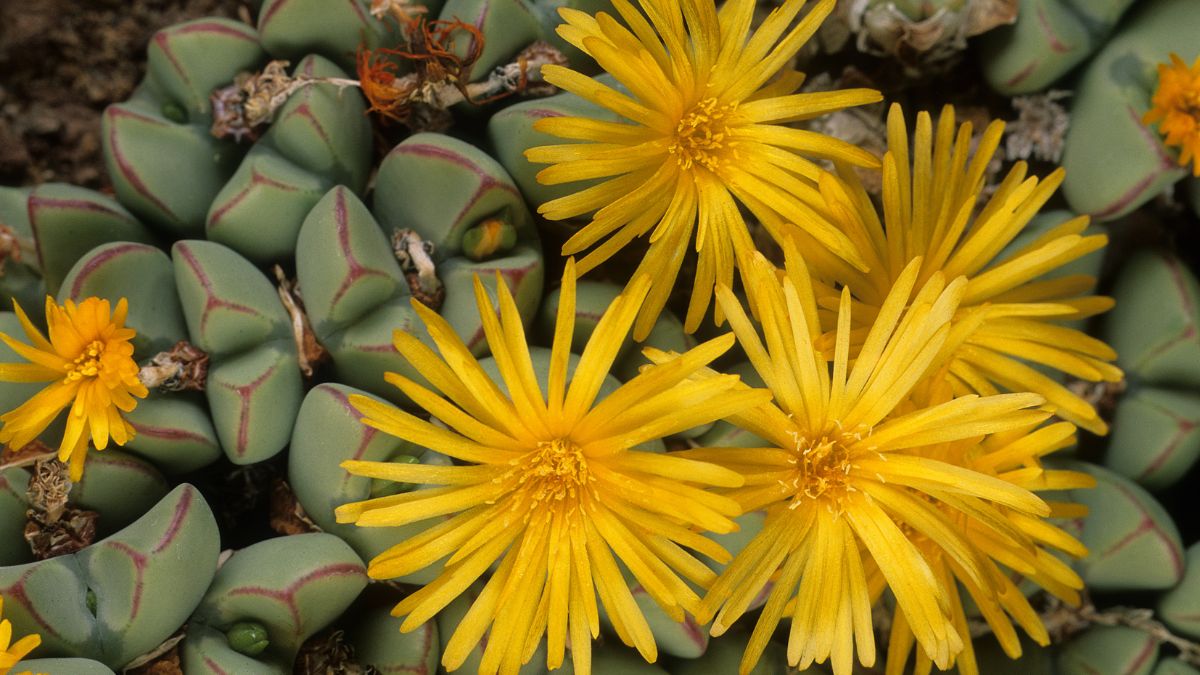Introduction to Conophytum
The succulent plant species Conophytum, which is indigenous to Namibia and South Africa, has enthralled gardeners all over the world. The Latin term “conus,” which means cone, and the Greek word “phytum,” which means plant, are the sources of the name “Conophytum.” These unusual plants are also referred to by a number of other names, including sphaeroids, conos, dumplings, button plants, knopies (buttons in Afrikaans), and waterblasies (water blisters in Afrikaans). We will go into the intriguing world of Conophytum in this piece and examine what makes them genuinely exceptional.
Taxonomy and Classification
Conophytum is a member of the Aizoaceae family, which is well-known for its unusual and varied selection of succulent plants. Conophytum is further divided into a number of species within this family, each having unique traits and adaptations.
Habitat and Distribution
The dry regions of Namibia and South Africa are home to these fascinating flora. They are typically found in rocky and desert environments in their natural habitats. Conophytums are ideal for dry gardens and succulent collections since they have evolved to flourish in these harsh conditions.
Morphology and Characteristics
What really makes Conophytum stand out is their appearance. Their distinctive, nearly stone-like appearance is created by the fusion of pairs of succulent leaves. Depending on the species, these “buttons” or “dumplings” might be anywhere in size from a few millimetres to a few centimetres.
Adaptations to Arid Environments
Conophytums have evolved a variety of adaptations to help them survive in their hostile environments. On the surfaces of their leaves, they frequently have translucent “windows” that let light in and prevent water loss. They can maximise the little resources they have thanks to this adaptability.
Cultivation and Care
Conophytums are popular among plant lovers due to their very simple maintenance requirements as well as their distinctive appearance. These plants are an excellent option for beginners to succulent gardening because they just need little watering, enough sunlight, and soil that drains well.
Popular Conophytum Species
Collectors and gardeners have great demand for some Conophytum species. Conophytum bilobum, Conophytum calculus, and Conophytum obcordellum are a few of the most well-known varieties.
Medicinal Uses
Certain Conophytum species have been used to cure a variety of illnesses in traditional medicine. It’s important to remember, though, that research is still being done on these methods’ efficacy and safety.
Conservation Status
Some Conophytum species are suffering conservation issues as a result of habitat degradation and unlawful collecting. Supporting initiatives to save these unusual plants and their natural habitats is essential.
Unique Features
The elaborate and varied floral displays at Conophytum are among its most notable qualities. These little blossoms, which are frequently only a few centimeters in diameter, enhance the allure of these diminutive succulents.
Cultivating Conophytums as Houseplants
If given proper care, conophytums can also make excellent houseplants. The secret to their success inside is to plant them in a sunny windowsill and to water them according to a proper timetable.
Tips for Propagation
Conophytums can be propagated via offset separation from mature plants or by seeds. Both approaches are quite simple for anyone who wants to increase the size of their Conophytum collection.
Common Pests and Diseases
Conophytums are relatively low-maintenance plants, however they are susceptible to common diseases and pests that affect succulents. Maintaining their health requires timely treatment and routine checks.
Fun Facts
Their distinctive conical shape is accurately described by the name “Conophytum”.
Some species of Conophytum are prized for having colorful, eye-catching blossoms.
Because they fit in so well with their rocky surroundings, these plants are frequently referred to as living stones.
Conclusion
Conophytum is a remarkable plant because of its exceptional adaptations to dry conditions and its appealing look. These button plants provide a one-of-a-kind and satisfying experience for gardeners of all skill levels, from seasoned succulent enthusiasts to those just starting out. Conophytum may provide a touch of elegance to your house or garden if you take the time to learn about and appreciate them.
FAQs
Can I grow Conophytum plants indoors?
With proper attention, Conophytums may survive and even flourish as houseplants, particularly in bright rooms.
What are the key care requirements for Conophytum plants?
They do best in full sun, on soil with good drainage, and with very occasional irrigation.
Are this endangered species?
Species extinction is a real possibility as a result of human activities such as the degradation of habitat and the unlawful gathering of animals and plants.
How can I propagate this plants?
They may be bred by sowing seeds or by dividing offsets from established plants.
Do Conophytums have any unique cultural significance?
They are highly valued for both their cultural importance in traditional medicine and their aesthetic value in gardening and succulent collections.









